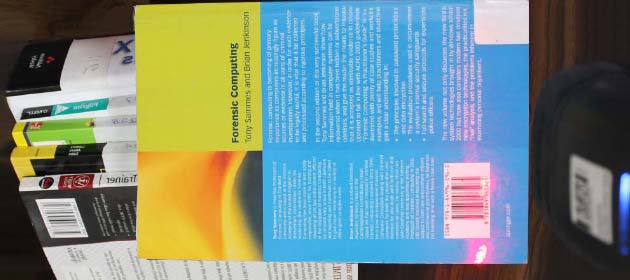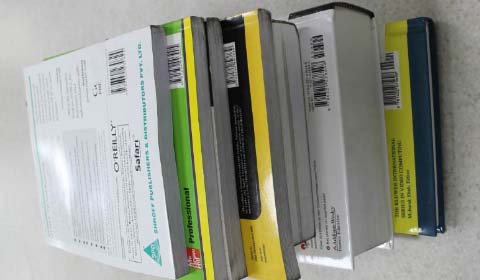Integrate Barcodes with Library Management System
Integrating barcodes with your library management system can help you automate your library's processes, reduce errors, and improve the overall efficiency of your library. Here are some steps you can take to integrate barcodes with your library management system:

-
Choose a Barcode System that is Compatible with your Library
Management System:
Ensure that the barcode system you are using is compatible with your library management software. Check with the software provider or documentation to see if they have any recommended barcode scanners or systems.
-
Set up your Library Management System to Accept Barcode
Data:
Configure your library management system to accept and process the barcode data. This may involve mapping the barcode data to the appropriate fields in your library management software.
-
Generate Barcodes for your Library Materials:
Use a barcode generator to create barcodes for your library materials, such as books and DVDs. Ensure that each barcode is unique and corresponds to a specific item in your library's catalog.
-
Scan Barcodes to Update Library Data:
Use a barcode scanner to scan the barcodes on your library materials. This will update the library data in your library management system, allowing you to track which items are checked in and out, their location in the library, and their availability.
By integrating barcodes with your library management system, you can automate many of your library's processes and reduce errors caused by manual data entry. This can help you save time, improve the accuracy of your library records, and provide better service to your patrons.
Incorporate Barcodes into Library's Self-Checkout System
Incorporating barcodes into your library's self-checkout system involves several steps. Here is a general outline of the process:
- 01 Choose the Right Barcode Scanner
Select a barcode scanner that is compatible with your self-checkout system and can read the type of barcodes used by your library. Consider factors such as scanning speed, accuracy, and durability when choosing a scanner.
- 02 Integrate Scanner with Self-Checkout
Connect the barcode scanner to your self-checkout system and configure it to read the barcodes used by your library. This may involve installing software drivers or configuring the self-checkout system to recognize the scanner.
- 03 Update your Library Catalog
Make sure that all of your library materials have barcodes attached and that the barcode information is up to date in your catalog. This ensures that the self-checkout system can correctly identify each item and link it to the appropriate account.
- 04 Train Staff and Patrons
Provide training for library staff and patrons on how to use the self-checkout system and the barcode scanner. This includes demonstrating how to scan items, interpret error messages, and troubleshoot any possible issues that may arise.
- 05 Test the System
Test the barcode scanner and self-checkout system to ensure that everything is functioning correctly. This includes testing the scanner's ability to read barcodes accurately and ensuring that the self-checkout system is properly linked to your library catalog.
By incorporating barcodes into your library's self-checkout system, you can streamline the checkout process, reduce wait times, and provide a more efficient and convenient experience for your patrons.
Handling Damaged or Unreadable Barcodes on Library Materials
Damaged or unreadable barcodes on library materials can cause issues with your library's circulation system and lead to difficulties checking items in and out. Here are some steps you can take to handle damaged or unreadable barcodes on library materials:
| Identify the Damaged or Unreadable Barcodes | Regularly check your library materials and identify any items with damaged or unreadable barcodes. This can be done using a barcode scanner or by visually inspecting the items. |
| Re-Label the Items | If a barcode is damaged or unreadable, you will need to re-label the item with a new barcode. This can be done by printing a new label using a barcode maker or by manually applying a new label. |
| Update your Library Management System | Once you have re-labeled the item, you will need to update your library management system to reflect the new barcode number. This will ensure that the item can be properly tracked and recorded in your system. |
| Remove Damaged Items from Circulation | If an item is damaged beyond repair or cannot be re-labeled, you may need to remove the item from circulation. Make sure to follow your library's guidelines for removing items from circulation. |
| Prevent Future Damage | To prevent future damage to your barcodes, consider using high-quality barcode labels and protecting the labels from moisture, heat, and other elements that may cause damage. |
By taking these steps to handle damaged or unreadable barcodes on library materials, you can help ensure the accuracy and efficiency of your library's circulation system.
Choose the Right Barcode Scanner for Library
Choosing the right barcode scanner for a library depends on the specific needs and budget of the library. Here are some factors to consider:
- ✅
Type of Barcode
Libraries may use different types of barcodes, such as Code 39 or 128. Make sure the barcode scanner you choose can read the type of library barcode.
- 📏
Scanning Distance
Consider the distance at which the scanner needs to be held to scan the barcodes. Handheld scanners can read them from a few inches to a few feet away.
- 🔨
Durability
Large libraries can be busy and barcode scanners may be used frequently, so choose a scanner that is high-quality, durable and can withstand heavy use.
- 🔗
Integration
Check if the barcode scanner can be easily integrated and compatible with your library management system or various other related software applications.
- 🔌
Wired Vs. Wireless
Wired scanners are usually less expensive, but wireless scanners provide more flexibility and can be used without being tethered to a computer.
- 💰
Budget
Barcode scanners range in price from less than $50 to several hundred dollars. Consider your budget and choose a scanner that meets your needs.
Overall, it is important to choose a barcode scanner that is reliable, easy to use, and meets the specific needs of your library.
Ensure that Barcodes meet Industry Standards for Library

To ensure that your barcodes meet industry standards for libraries, you should follow the guidelines and recommendations established by the International Organization for Standardization (ISO) and the International Electrotechnical Commission (IEC). The ISO/IEC 15416 standard outlines the specifications for the print quality of barcodes, and ISO/IEC 15418 provides guidelines for the data content and structure of barcodes.
For library books, the industry standard barcode symbology is Code 128, which can encode both numeric and alphanumeric characters. The barcode should be printed with a minimum height of 12.7mm (0.5 inches) and a minimum width-to-height ratio of 2:1.
In addition, libraries often use a unique barcode prefix or library identifier to distinguish their materials from those of other libraries. This prefix is typically included in the barcode data structure and should be registered with the appropriate standards organization to ensure uniqueness and compatibility with other library systems.
To ensure that your barcodes meet industry standards, you may consider using a barcode verification service or investing in barcode verification equipment to test the quality and accuracy of your printed barcodes.